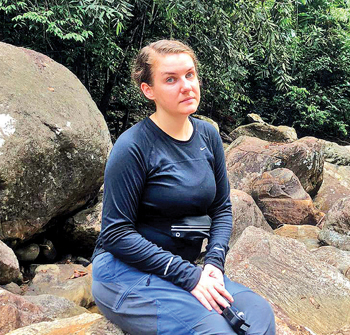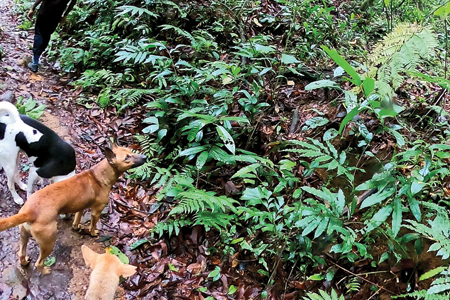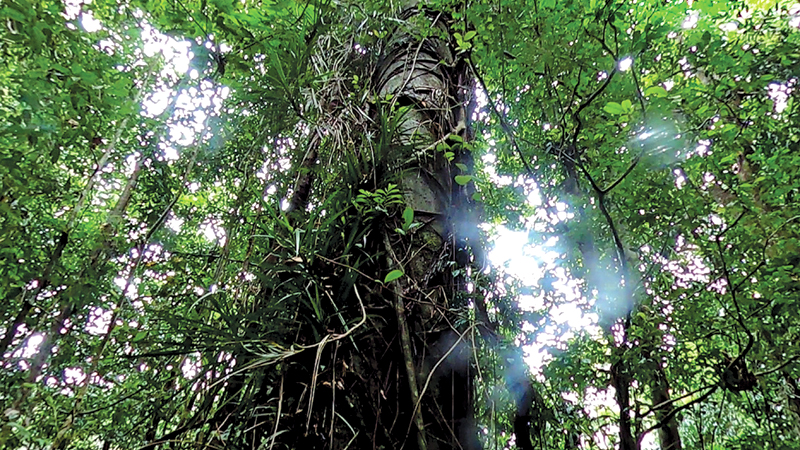In the lush tropical rainforests of southwest Sri Lanka, Kosala gets ready in the early, humid morning to guide another group of local and foreign visitors. I tuck my trousers into my socks and add some drops of lemon oil to my shoes and hands, as Kosala taught me on my first day here. It rained during the night, and he tells me to expect to meet more leeches than usual. I have accompanied Kosala and other guides for almost two months on long forest walks to explore how humans and other-than-humans are co-contributors and co-producers of sustainable tourism.
 “Other-than-humans” is a relational approach that extends beyond the biological – encompassing all life forms such as animals, plants, non-tangibles and even materials – without invoking a hierarchisation.
“Other-than-humans” is a relational approach that extends beyond the biological – encompassing all life forms such as animals, plants, non-tangibles and even materials – without invoking a hierarchisation.
My University of Illinois research project, “More-than-Human Tourism: Walking With a Rainforest,” aims to inform how sustainability can be redefined as relational because of these connections.
Multispecies ethnography
The walking “with” method recognises that non-humans are also co-producers of these tourism experiences and enables me to explore how they interact with us and influence what and how we communicate about them.
I use multispecies ethnography – a combined genre of writing and anthropological research that is sensitive to the lives and needs of non-human organisms – to study how the human guides and other-than-humans interact.
This requires attentiveness to sensory experiences, while recognising that I cannot detect or experience everything that is around me due to the limitations of my human body and its senses.
The two dogs that live in a house on the edge of the forest reserve often accompany us on our long walks. They know the road and trails well and usually walk in front of the visitor groups. Some people consider the two dogs a nuisance, while others enjoy their company.
Sometimes, the dogs run off into the dense forest in a way that we, with our human bodies, would have difficulty doing because of the thick vegetation. I find that I am attentive to the dogs’ reactions, what they listen to and look at. Understanding their ability to guide visitors’ experience teaches me about interdependencies and multispecies relationships.
We have walked for over an hour, following the narrow and muddy paths, when the group suddenly halts. “Look,” Kosala says softly, pointing towards a spider almost as big as my palm. While it is only an arm’s length away from the face of one visitor, who gasps, it is still hard to see the large web and the enormous dark spider with light markings on its body.
 In the rainforest, I have been bitten by leeches and mosquitoes, cut by sharp leaves and scratched by low-hanging branches. During my many walks, encounters and chats, I have learned a lot about the area, but more importantly, I have learned that I can walk with the forest.
In the rainforest, I have been bitten by leeches and mosquitoes, cut by sharp leaves and scratched by low-hanging branches. During my many walks, encounters and chats, I have learned a lot about the area, but more importantly, I have learned that I can walk with the forest.
Getting bitten by a leech, hearing a blue magpie’s chatter, nearly walking into a giant wood spider and its web, wading across a river and climbing over wet, slippery fallen trees after a storm provide a variety of sensory, intangible and tangible experiences that shape our walk in – and with – the forest.
Directly and indirectly, tourism relies on non-humans, often as the main attractions. However, when walking with the forest, we understand that these non-human counterparts are more than entertainment for us human visitors – they shape our experiences in very significant ways.
The human guides are central to these introductions and interactions. Kosala grew up in the area, on the border of the current forest reserve. He has worked as a guide in the reserve for over seven years and has formed intimate relationships with the forest, various species and individuals over time.
In tourism settings, visitors interact with native flora and fauna for a short time. But these direct encounters can have long-lasting and sometimes devastating consequences for other life forms and organisms, underscoring the vital need to address how people come to know them.
“Animls are not here for the tourists,” Kosala says, “Some are here because they have learned and enjoy the benefits they get, but some must adjust in other ways to human visitors. We have to understand that.”
Mutuality
Tourists affect other-than-humans because of their culture, economics and politics. It is critical to map the mutuality of these relationships to avoid furthering systemic oppression. Rethinking our relationships with non-human species and organisms in Western tourism ideas and practices helps us recognise existing connections that are often overlooked.
Kosala says that some visitors such as birdwatchers are disappointed and frustrated when they do not encounter a specific species they want to see, while other visitors just want to enjoy the forest environment in general and are happy to learn a thing or two.
 When I ask other visitors what made the most impression or surprised them, many people reveal a newfound fascination with a species they were unaware of before their visit, usually not the charismatic megafauna – the large and attractive animals that typically are the centre of attention in much nature-based tourism. Instead, visitors mention unfamiliar plants and invertebrates that left lasting impressions.
When I ask other visitors what made the most impression or surprised them, many people reveal a newfound fascination with a species they were unaware of before their visit, usually not the charismatic megafauna – the large and attractive animals that typically are the centre of attention in much nature-based tourism. Instead, visitors mention unfamiliar plants and invertebrates that left lasting impressions.
Human and non-human bonds
Notions of sustainability tend to be human-centric in that they downplay the roles of non-humans and their mutual interdependencies. Expanding on sustainability’s relational qualities, my study furthers our understanding of these crucial relationships among humans and non-humans in tourist settings. If non-humans are perceived as co-producers and stakeholders in tourism, it can lead to changes in decision-making processes and conversations about natural areas and tourist activities.
Emma Lundin, a University of Illinois doctoral student in tourism, spent two months in a rainforest reserve in Sri Lanka shadowing forest guides. Lundin sought to understand how the guides interact with other-than-humans to create tourism experiences. Tourists’ encounters with life forms and organisms that flourish in these spaces can have long-lasting and devastating consequences, which makes it critical to study these interactions and understand tourism as more-than-human. [email protected].









